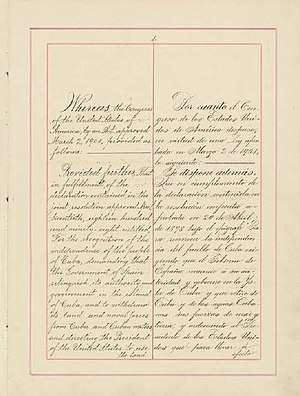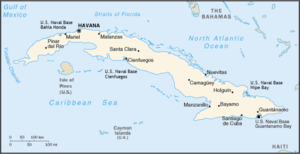Cuban–American Treaty of Relations (1903)
The 1903 Cuban–American Treaty of Relations (Spanish: Tratado Cubano–Estadounidense) was a treaty between the Republic of Cuba and the United States signed on May 22, 1903. The treaty contemplated leases of Guantánamo Bay; one such lease had been executed earlier in the year in February 1903, and a second lease was executed later in the year in July 1903.
 Page one of the 1903 Treaty of Relations, including the Platt Amendment | |
| Signed | May 22, 1903 |
|---|---|
| Location | Havana |
| Effective | July 1, 1904 |
| Expiry | June 9, 1934 |
| Signatories |
|
| Citations | 33 Stat. 2248; TS 437; 6 Bevans 1116 |
| Also known as the Permanent Treaty (6 Bevans 1126). Amended by supplementary convention of January 20, 1903 (TS 438; 6 Bevans 1123). Abrogated by the Treaty of Relations of 1934 on June 9, 1934 (TS 866; 6 Bevans 1161). | |
The 1903 Treaty of Relations
U.S. law directed the president to cede control of Cuba to its government only when that government had endorsed the seven provisions established in U.S. law by the Platt Amendment of March 1901. The 1903 Treaty of Relations noted that Cuba's Constitutional Convention had, on June 12, 1901, added the Platt Amendment provisions to its constitution on February 21, 1901. Those provisions, among other things, restricted the independence of the Cuban government and gave the U.S. the right to oversee and at times interfere in Cuban affairs. The Cuban government had taken power and the U.S. withdrawn its forces as of May 20, 1902. The final provision of the Platt Amendment required that its other provisions be adopted by treaty as well. The Treaty of Relations, signed in May 1903, accomplished that.
The 1903 Treaty of Relations was used as justification for the Second Occupation of Cuba from 1906 to 1909. On September 29, 1906, Secretary of War (and future U.S. president) William Howard Taft initiated the Second Occupation of Cuba when he established the Provisional Government of Cuba under the terms of the treaty (Article three), declaring himself Provisional Governor of Cuba.[1][2] On October 23, 1906, President Roosevelt issued Executive Order 518, ratifying the order.[1]
The 1903 Treaty of Relations was superseded by the 1934 Treaty of Relations, which abrogated in large measure the 1903 treaty while affirming the U.S. right to lease land for a naval station and continuing to hold the U.S. blameless for actions taken before the establishment of the Republic of Cuba in 1902.
The 1903 lease treaties
One lease that accomplished what the treaty contemplated had been executed earlier in the year and a second lease was executed later in the year. The lease treaty agreed to from February 16-23, 1903 stipulates that the Republic of Cuba lease to the United States specific lands in Cuba, notably the land that surrounds Guantánamo Bay, for the purpose of coaling and naval stations, for as long as necessary. The lease stipulates that the United States "shall exercise complete jurisdiction and control", while recognizing "the continuance of the ultimate sovereignty of the Republic of Cuba". Cuban vessels involved in trade will have free passage through the waters. The United States has the right to modify the waters as necessary.
Under the lease treaty signed on July 2, 1903, the U.S. must send $2,000 in gold as payment to the Cuban government each year. After the Gold Reserve Act of 1934 removed the U.S. gold standard, lease payments were made in dollars. The payment due on July 2, 1974, was made by check in the amount $4,085.[3] With inflation, $2,000 of 1903 dollars would be worth about $4,085 in 1934 and would be further increased to over $52,000 in 2013; however the payment remains at $4,085. Since the Cuban Revolution, the Cuban government has cashed one of these checks, and only because of "confusion" in the early days of the revolution. The other checks, made out to "Treasurer General of the Republic", a position that has not existed since 1959, were once shown stuffed in a desk drawer in Castro's office during a television interview with him.[4]
American perspectives
The treaty fell short of the original desires of both the United States government and its military cabinet in Cuba. Their aim was to lease four naval bases located in strategically favorable port areas of Cuba, including Guantánamo Bay. The other three were Bahia Honda (close to the Cuban capital of Havana), Cienfuegos, and Nipe Bay. [5]
Cuban perspectives

The government of Cuba argues[6] that the base is a constant affront to its sovereignty, taken under duress and maintained under the threat of atomic force. It has complained that weapons are smuggled into Cuba through the base and that the base shelters criminals fleeing from Cuban justice.
Cuban-American Professor Alfred-Maurice de Zayas argues that the lease may have been invalidated by material or fundamental breaches of its terms.[7] The February 1903 lease, in Article II, states that the United States is allowed "generally to do any and all things necessary to fit the premises for use as coaling or naval stations only, and for no other purpose." He questions whether the prison facility meets those criteria.
References
- Records of the Provisional Government of Cuba, National Archives and Records Administration. "Established: By a proclamation of the Secretary of War, September 29, 1906, under general authority of the Permanent Treaty of 1903 between the United States and the Republic of Cuba, with oversight responsibilities assigned to the Bureau of Insular Affairs (War Department) by EO 518, October 23, 1906. ... History: Military Government of Cuba established by Maj. Gen. John R. Brooke, December 28, 1898, as a consequence of U.S. invasion and occupation of Cuba in the Spanish–American War, in accordance with Presidential order published in General Order 184, Headquarters of the Army, December 13, 1898. Spanish colonial administration formally terminated, January 1, 1899. Republic of Cuba established by transfer of sovereignty, May 20, 1902. Domestic unrest in Cuba led to the proclamation of September 29, 1906, which designated Secretary of War William H. Taft as Provisional Governor of Cuba. Taft succeeded as Provisional Governor by Charles E. Magoon, October 13, 1906. EO 518, October 23, 1906, ordered Governor Magoon to report to the Secretary of War through the Bureau of Insular Affairs. Military government terminated January 28, 1909."
- the 1906 Taft proclamation
- Strauss, Michael (2009). The Leasing of Guantanamo Bay. Appendix 12: ABC-CLIO Inc. p. 253. ISBN 0313377820.CS1 maint: location (link)
- Boadle, Anthony (August 17, 2007). "Castro: Cuba not cashing U.S. Guantanamo rent checks". Reuters. Retrieved September 3, 2012.
- ISBN 978-0-313-37782-2 The Leasing of Guantanamo Bay, Michael J Strauss p50
- US Joint Publications Research Service, 1977, pdf, English translation of 1970 Spanish document "Crimes and Provocations". Selected official comments made from 1960–1963, regarding the US occupation of Cuba, starting at page 31
- The Status Of Guantánamo Bay And The Status Of The Detainees, Alfred de Zayas. November 19, 2003 presentation
External links
- Cuban-American treaty, May 1903 — 1903 Treaty of relations text
- Lease text, February 1903 — boundaries (full text)
- Lease text, July 1903 — obligations (full text)
